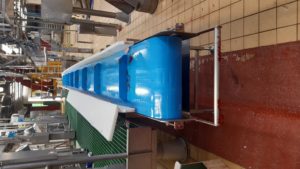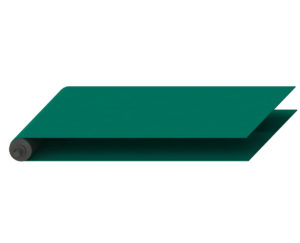The answer is YES!
For each daily wash with a positive drive belt type DEL/DRIVE 50 you save: 62% water and 63% less cleaning time
Many of you have asked us this question, especially in the food industry.
Each time, we get the same answer, but we have very few figures to back up our yes!
To have the key information to confirm the points that we were sensing, we conducted a study in a slaughterhouse in Brazil.
The framework of the study
Weco correis do Brasil, our local distributor, asked BRF to be our tester. BRF, the world’s leading meat company, agreed to be tested at one of its production sites.
This site is equipped with 2 cutting lines of equal capacity. The production managers chose to implement a positive drive belt from Mafdel, on the advice of Weco, to compare the results with the modular belt originally used on the conveyors. The DEL/DRIVE 50 was selected to avoid major conveyor modifications.
Results of the study
The results are clear and based on factual data:
1- For belt cleaning using the DEL/DRIVE 50 the operators save on average 13 minutes per day.
2- For water consumption: 514,44 litres of water are saved per each cleaning.
In addition, the operators noted that they used less detergent. It should be noted that this data was not part of the study, but the observation is there.
To find out more about the methodology and detailed results, download our white paper
These two-axis figures clearly show the positive impact of such a positive drive conveyor belt installation on a production line.
We also know that the service life of positive drive mono-material belts is longer (under normal use) and therefore the life before replacement is longer than other belts on the market.
If you would like to know more, please contact us or contact Weco do Brasil directly.
Sapevate che i primi nastri trasportatori con rivestimento sintetico per alimenti sono apparsi negli anni ’60?
A ben vedere, è evidente che i 30 gloriosi anni di industrializzazione hanno portato innovazioni in questo campo, e ad ogni nuovo prodotto ne corrisponde un altro più igienico, più facile da pulire e da usare.
Abbiamo tracciato queste innovazioni in alcune immagini e commenti.
Oggi ci interessa soprattutto sapere come vengono utilizzati questi nastri trasportatori e quali sono i loro vantaggi per gli utenti:
- Igiene
- riduzione dei costi
- bassa manutenzione
- affidabilità
- conformità
Sembrano essere i criteri chiave per la maggior parte dei settori.
Quali saranno le alternative di domani?
Sempre più prestazioni per i nastri monomateriale a trasmissione positiva:
- Nessuna contaminazione
- Nessuna delaminazione
- Resistente alla scheggiatura delle plastiche dure
- Nessun rifugio per i batteri
- Semplice da installare in loco
- Funzionamento silenzioso
- Risparmio di acqua, prodotti chimici e manodopera
- Approvato da UE, FDA e USDA
…
Cosa ne pensate?
Sentitevi liberi di condividere le vostre opinioni e di farci domande!
Se desiderate il materiale di presentazione, è disponibile per il download gratuito in lingua inglese.
Il video di presentazione completo è qui.
I nostri 3 nuovi cataloghi sono le vere bibbie del nastro trasportatore e del nastro termosaldabile: troverete tutte le novità del 2022 in 3 edizioni:
- nastri termosaldabili,
- nastri trasportatori termosaldabili,
- nastri trasportatori a trazione positiva.
Al fine di promuovere il nostro impegno verso il pianeta e di adattarci ai nuovi modelli di consumo, abbiamo reso tutte le versioni digitali disponibili qui.
I team Mafdel sono sempre pronti ad aiutarvi a trovare il prodotto giusto e a discutere i vostri progetti attuali e futuri: contattateci!
The needs of this meat producer
A customer of Mafdel, involved in pork processing, has opened its doors to us to reveal how our new monolithic belt products work within his plant. Our client, a long standing customer of over twenty years, has previously experienced the benefits of Mafdel’s existing range of monolithic products and has now installed two more of our products within his process.
In this study, we focus on two stages: the pre-pasteurisation stage and the post-pasteurisation stage.
We have installed two different belt types to satisfy the requirements of our customer:
- Hygiene,
- Ease of cleaning,
- Positive drive.
The pasteurisation process
Pasteurisation is very short stage in the overall process but essential, nevertheless. The pork is conveyed upstream, to end up in a loaf which is then wrapped in plastic. This plastic wrapped ham loaf is then pasteurised where the temperature is raised to 100°C and then cooled immediately within a few seconds. At the end of this tunnel, the operator removes the plastic film, and the belt conveys the loaf to the slicer. The purpose of this step is to eliminate any bacteria.
For this operation, we have advised the use two different belt types.
The choice of the plant manager
Belt #1 – Positvebelt:
- positive drive,
- exceptional guidance,
- tension-free installation,
- resistance to high temperatures,
- optimal hygiene.
Belt #2 – S/Drive:
- hygienic construction: easily removed for daily cleaning,
- compatible with the existing positively driven conveyor,
- discourages bacterial growth.
These two belts were chosen because they are dismantled daily for cleaning. The operators have also been trained to weld and fit them. Furthermore, the S/Drive did not involve changing the existing conveyors in any way. The belt was designed to run with the existing competitor drive sprockets and wheels.



S/Drive before the cutting stage
The results
To date, our customer has been satisfied with the installation, and has found that their teams spend more time on production than on maintenance and cleaning. In addition, the fact that the belts are made from a single piece of material means that they are extremely hygienic, easy to clean, are chemical resistant and there are significant water, labour and chemical savings.
The Production Manger was quoted as saying; “This equipment is more than beneficial for our production line”
The pasteurisation process is common to the meat processing industry. We are involved, on a regular basis, both to renew existing belts and to assist in the design of new equipment directly with the users or with their machine suppliers.
Mafdel sarà chiuso venerdì 24 dicembre, giovedì 30 dicembre e venerdì 31 dicembre.
Vi preghiamo di prendere in considerazione questi 3 giorni per i vostri prossimi ordini.
Buona stagione delle vacanze!


Towards optimisation of maintenance and production processes
A sheep slaughterhouse has commissioned a set of conveyors designed with two positively driven conveyor belts that transfer sheep offal. The conveyor belts comprise synchronised compartments created by cleats to keep each set of organs separate. The operators can then keep weigh them individually and get a quality endorsement that the offal is fit for consumption.
The conveyors are equipped with the new S/Drive positive-drive monolithic conveyor belts, some with cleats, others smooth.
The factory has fitted all its conveyors with Mafdel belts, and this has reduced water and chemical consumption as well as labour and cleaning time. The time saving results in increased output.

The proposed solution enabled the client to achieve its objectives:
- -Save production time vs. maintenance time
- To equip with hygienic belts
- Savings in operating costs
Similar options are available for other types of meat processor where compartments can be created on the basic belt. This type of belt can be produced in any length or width required for full adaptation to the different products carried.
What is electrostatic charge?
An electrostatic discharge (ESD) is a passage of electric current between two objects with different electrical potentials over an extremely short time.
In the case of our industry, the electrostatic charge may result from friction between the belt and the conveyor bed, from movement of the product on the belt; or in dry, dusty conditions, from ionisation of the air.

What problems can static charge cause in your production processes?
Static current can often cause problems such as:
- The static charge can attract foreign bodies to the belt such as dust and small items of debris. These can then contaminate the product.
- Static charge can ignite flammable items.
- Static charge can destroy sensitive electronic components.
- Static charge can cause extreme discomfort to line operatives.
What solution do Mafdel provide?
We have added an antistatic component to some of our existing materials and created:
Souplex antistatic round profile – Available in 4,5 and 6mm Ø
Del/Flex antistatic conveyor belting – An antistatic conveyor belting available in 3mm thickness
Mafdel antistatic products are fully compliant with current EU standards.
These products are used in the electronics, chemical, and pharmaceutical industries and in some areas of the logistics industry.
If you are interested in discovering more about the Mafdel and BMTS antistatic range you can find technical specifications in this explanatory sheet : Mafdel- DEL-FLEX -SOUPLEX – Antistatic-EN
Bientôt 10 ans que le traitement antimicrobien a fait son apparition dans nos gammes de bandes transporteuses dédiées à l’agroalimentaire.

Pignon Del/Drive50
Qu’est-ce qu’un traitement antimicrobien ?
Ce traitement permet d’inhiber la prolifération des bactéries et évite la contamination des produits transportés. L’efficacité ne diminue pas au fil du temps et est conservée sur toute la durée de vie de la bande.
Il améliore également la sécurité alimentaire et allège les procédures de nettoyage et désinfection. Il est évident que le nettoyage avant et après transport des matières reste un élément essentiel pour conserver un niveau d’hygiène élevé.
Cette possibilité offerte aux professionnels vient en complément des procédés existants d’hygiène et de sécurité dans l’agroalimentaire.
Quid de la législation ?
Pour répondre simplement, les revêtements antimicrobiens sont neutres et conformes au règlement UE 10/2011, ainsi qu’aux exigences de la FDA pour l’Amérique du Nord.

Pignon Positivebelt
Quels produits bénéficient de ce traitement ?
Aujourd’hui nous avons choisi de proposer deux produits antimicrobiens pour un usage dans les industries agroalimentaires.
Les bandes monomatières thermosoudables à entraînement positif Del/Drive 50 et Positivebelt.
Le traitement antimicrobien dans la masse vient s’additionner aux caractéristiques existantes de nos bandes sans les altérer tout en apportant les avantages suivants :
- Inhibe le développement de bactéries, moisissures et autres micro-organismes, sur toute la bande :
- Dans les zones peu accessibles où le nettoyage est délicat,
- Lorsque les surfaces de bande présentent de l’usure, des rayures ou des accrocs, véritables foyers de bactéries.
- Retarde la nécessité de remplacement de la bande : maintenance préventive.
- Allège les procédures de nettoyage et de désinfection.
Toutes les spécifications techniques sont disponibles dans la fiche téléchargeable Mafdel-Antimicrobiennes-FR
Ces produits correspondent à vos attentes en termes d’hygiène et de sécurité ? N’hésitez pas vous mettre en relation avec l’un de nos experts du domaine agroalimentaire pour évaluer précisément votre besoin.
How can a fragment of plastic, a piece of glass or metal be detected before it becomes a foreign body in a food product?
The current reality…
The French trade magazine Process Alimentaire has conducted a survey which revealed that; “product recalls due to foreign bodies have represented 5% of recall notices since June 2020 […]”.
(Source: Process Alimentaire – July-August 2021 – n°1393 – p57 – “Foreign bodies – How to detect the invisible”)
From Mafdel’s food industry customers, there is a crucial question; “how can we be certain that the blue TPU will not be found in our food products?”
To which, our response is:
“There is no miracle solution but Mafdel’s monolithic belts are the least likely of all belting products to shed contaminating material. Zero risk however, does not exist!”
Whilst our response is true, there has been undeniable technical progress made in area of metal detectability in plastics. This valuable feature is now available in several new Mafdel belting types. An inert and food-compliant (EU 10/2011 hygiene standards) component can now be blended with the same premium quality TPU material that is used in our standard TPU products to provide an enhanced level of food safety.
The result is a belt that, were it to shed material from mechanical impact, those pieces stand a far higher chance of being detected using a standard metal detector. The risk of plastics contamination is significantly reduced.
3 belts are now in our metal detectable range:
– Blue Del/Flex V-belt,
– ATC-63 blue belt
– Round belt, blue Del/Flex.
Their main and common characteristics are:
– Monolithic, waterproof and rot-proof.
– Resistant to water, detergents, animal and vegetable oils and fats.
– Temperatures resistant from -20°C to +70°C
– Quiet operation
– Metal detectable.
All technical specifications are available on the appropriate product sheet Mafdel-Belts-Metal-Detectable-EN
Un po’ di storia…
I nastri monolitici ad transmissione positiva Mafdel sono stati con noi per un certo numero di anni e sono stati un grande cambiamento nel portare l’igiene del nastro al livello successivo. La maggior parte dei principali produttori hanno qualcosa nella loro gamma che è monolitico o, almeno, soddisfa il ruolo di un nastro monolitico igienico. La parola monolitico descrive una “struttura immutabile” o un “singolo materiale”, quindi, qualsiasi nastro che ha più di un componente, per esempio, un nastro che contiene corde, non è monolitico ma un tipo di corde rinforzate o disperse.
Prima di addentrarmi nella spiegazione di come funziona una cinghia monolitica Mafdel a trazione positiva, è importante capire che le cinghie veramente monolitiche e quelle a corde disperse funzionano in modi significativamente diversi. Capire questa differenza fondamentale è importante per ottenere il meglio da una cinghia Mafdel.
La differenza critica è che un nastro a cavo funziona sotto tensione, mentre un nastro veramente monolitico funziona con tensione zero. Lavorare con un nastro veramente monolitico significa che il metodo di giunzione è più semplice, più veloce, è totalmente privo di tessuto e offre l’opportunità di creare trasportatori aperti e meno costosi.
Come funziona?
Per ribadire, un nastro veramente monolitico (senza tessuto o corde) non dovrebbe MAI essere messo in tensione. Quindi, come funziona effettivamente un nastro monolitico a tensione zero?
Tutte le cinghie si allungano, o con una pretensione applicata o attraverso l’allungamento in funzione dovuto al carico applicato. Una cinghia monolitica a comando positivo Mafdel è progettata per allungarsi fino al 2,5% a pieno carico durante il funzionamento e poi rilassarsi al suo stato originale quando il carico viene rimosso. Questo allungamento è una caratteristica progettuale deliberata e funzionerà così per molti anni. Come scritto in precedenza, un nastro a tensione zero permette un migliore accesso per la pulizia, un design del trasportatore più leggero e aperto e un minore consumo di energia. Sorprendentemente, un Polyester Del/Drive 50 largo 1000 mm è in grado di trasportare un carico teorico di oltre dieci tonnellate nelle giuste condizioni!

Se osservate attentamente la foto di un Del/Drive 25 qui sopra, noterete che il dente alla base della ruota dentata è in contatto con la barra di trasmissione sul nastro ma, man mano che si procede in senso orario, lo spazio tra la barra di trasmissione e il dente diventa progressivamente più grande. Questo perché il passo della cinghia è più piccolo del passo della ruota dentata. Se si applica la suddetta tensione del 2,5%, tutti i denti si innestano e la cinghia è quindi alla massima potenza. Riducendo il carico, il passo della cinghia si accorcia e il contatto dei denti si riduce di nuovo. Il carico crea la tensione tra esso e la ruota dentata.
Il fattore chiave della progettazione è che la tensione zero permette alla cinghia di “strisciare” sul pignone durante l’allungamento, permettendo il movimento dei denti nel pignone. Per un monolitico, questo è essenziale.
Quindi, cosa succede se tendo una cinghia monolitica a trazione positiva?
Beh, accadono due cose: in primo luogo, la pretensione applicata prende il posto della capacità di carico disponibile, quindi, quando si tende, la cinghia si sta già avvicinando alla sua capacità di carico massima. Quando poi si aggiunge il carico da trasportare, la cinghia viene sovraccaricata con il passo dei denti della cinghia che si estende più a lungo del passo della ruota dentata. Il risultato è che la cinghia salta i pignoni. L’altro problema è che la cinghia non sta più guidando contro la faccia delle barre di trasmissione e ora è diventata una trasmissione a frizione. Questo ostacola il movimento del pignone contro la parte posteriore della cinghia. Se il pignone non si può muovere, c’è un alto rischio che i denti possano scavalcare la parte superiore dei denti e di nuovo, si ha una cinghia che salta. Se si rimuove il pretensionamento e si fornisce un po’ di catenaria, il salto scompare e la cinghia funziona come è stata progettata.
Spero che questa spiegazione aiuti a rimuovere alcune delle idee sbagliate che circondano le cinghie a tensione zero e se volete discutere ulteriormente.
Non esitate a contattare un esperto Mafdel.


















